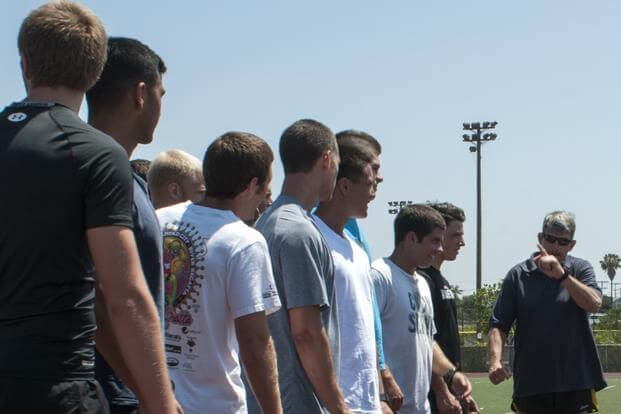The Navy Physical Screening Test (PST) is a difficult fitness test, but it’s also the first and one of the most important steps in becoming a member of Navy Special Warfare and Special Operations. Prior to boot camp, aspiring Navy Special Amphibious Reconnaissance Corpsmen (SARC) must now take the PST, which is the same test required for Navy SEAL, SWCC, EOD/Diver and Rescue Swimmer candidates.
The PST is an important part of the Navy’s selection process, and it’s designed to test your physical fitness and mental aptitude. To ace the PST, you’ll need to prepare in advance.
Here is an email from a candidate in the delayed-entry program working to improve his running and swimming:
Hello, Mr. Smith. I’m aspiring to become an HM-ATF (Hospital Corpsman Advanced Technical Field), also known as Navy SARC. I'm reaching out for help on my weakness. I took the PST and am not scoring well enough to get a contract. My weaknesses are swimming and running. My swim time was 16:12 for 500 yards and 13:16 for the 1.5-mile run. I come from a football background. What do I need to do to quickly get better at running and swimming? I can't maintain a good pace with running, and my swimming is just not as good as I should be. I also get very tired fast when I run just 1 mile. What do I need to do to fix these problems? Thanks for all you do. -- Rick
Here is my advice to those considering jobs that require higher physical standards prior to joining the military. This advice does not apply to Rick, but for others reading this: My No. 1 rule and recommendation is not to even talk to a recruiter until you can ace the PST.
The reason is that your delayed entry may not allow enough time for you to get the scores on the entry-level fitness test that you will need to get accepted into these special programs. Do not take this risk, as it may take you several months to get into the shape you need to both get accepted into the program and actually make it through the selection training process.
1. Develop or Get on a Training Plan
A good training plan will help you focus on the skills and drills you need to master. Develop a plan that includes cardio, strength and agility exercises. Make sure to build rest days into your plan to give your body time to recover.
For Navy SARC, you will be working with Marines, so you will also have to take and perform as well as the RECON Marines on the USMC PFT, CFT and the RECON Physical Assessment Test (RPAT) and RECON Training. This will mean having to swim 500 meters in cammies, running a timed 3 miles, treading water well, and many other testing events.
2. Stick to Your Plan and Learn Your Pace
For your swimming workouts, focus on increasing your pace by learning proper pulling, kicking and gliding technique. Then focus on your endurance. Film yourself swimming 50 meters and compare it to the side stroke critiques I have posted on social media (YouTube, Instagram).
Try the 50-50 Swim Workout. It has a proven track record of helping people go from 12+ minutes down to 9 minutes in as little as 3 to 4 weeks if you swim 4 to 6 days a week and learn proper technique first.
When it comes to running, it's important to focus on building endurance and goal pace speed (not sprinting like football). Start by running short distances of 400 meters at your goal pace for 1.5 miles and gradually increase the distance as your fitness level improves.
3. Eat Well and Rest Well
Eating a balanced diet is essential for your physical energy and high-octane test performance fuel. Make sure you’re consuming carbs like fruits and vegetables. See ideas for nutrition for energy for training and testing from Army nutrition Ph,D. Lt. Col. Nick Barringer.
Finally, remember to rest and recover. Make sure to take at least 1 to 2 days off from training per week to give your body time to recover and rebuild. Get enough sleep. Sleep helps your body recover and gives you the energy you need to tackle the PST. Aim for 7 to 8 hours of sleep each night.
4. Practice, Practice, Practice the PST and USMC PFT/CFT and RPAT
You need to take the tests many times so that you not only build your conditioning and techniques for both running and swimming, but learn pacing strategies to reach your goal times on these events. There is more to this journey than just the Navy PST that you take during your delayed-entry process.
Given the job you want in the military, you will have time after boot camp to do more training for the challenges ahead. You will attend Corpsman A school for 14 weeks. With the right preparation and dedication, you can ace the PST as well as the USMC PFT/CFT and RPAT tests.
You need to be able to do them all. If you do not have time to ace the PST prior to departing for boot camp, still go Corpsman (HM) rating, as you can move over to the “Green Side” and work with Marines to build up to becoming a SARC corpsman.
-- Stew Smith is a former Navy SEAL and fitness author certified as a strength and conditioning specialist (CSCS) with the National Strength and Conditioning Association. Visit his Fitness eBook store if you're looking to start a workout program to create a healthy lifestyle. Send your fitness questions to stew@stewsmith.com.
Want to Learn More About Military Life?
Whether you're thinking of joining the military, looking for fitness and basic training tips, or keeping up with military life and benefits, Military.com has you covered. Subscribe to Military.com to have military news, updates and resources delivered directly to your inbox.


















